
Lima refinery marks sweet 125
Facility oldest in state to run crude constantly
6/5/2011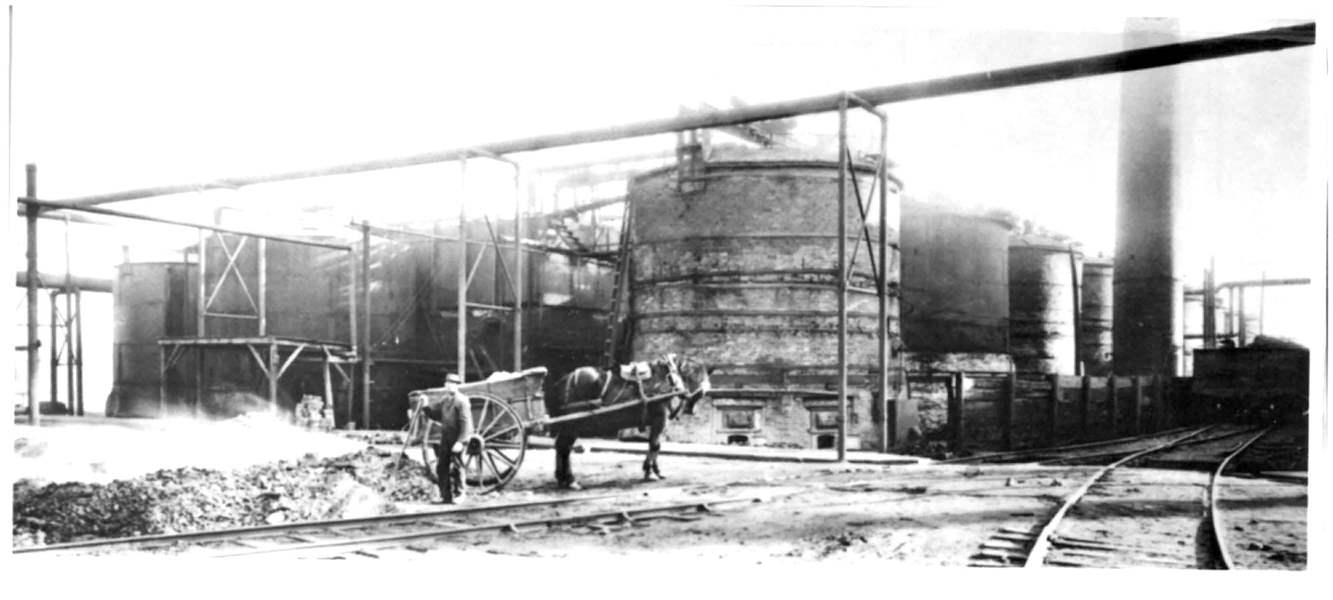
The sweetening stills begin to take shape in this photo, which was taken sometime during the oil boom.
Husky Energy
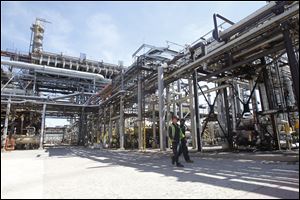
Employees walk through the grounds at the Husky Lima Refinery, a 1,100- acre complex that employs 430 hourly workers.
LIMA, Ohio -- It is the same age as both the Statue of Liberty and Coca-Cola, but nowhere near as famous, even in its own hometown, and it makes about one of every four gallons of gasoline consumed in Ohio each year.
And though it has gone by at least seven different names across its 125-year history and teetered on the brink of closure several times, the 160,000 barrel-per-day crude oil refinery in Lima -- the oldest continuously operated refinery in Ohio -- has simply kept on cracking crude into more usable petroleum products.
Husky Energy Inc., the latest owner of the Lima refinery, will mark the refinery's anniversary with a June 12 celebration at the Allen County Museum, from which Husky will conduct small groups on tours of the 1,100-acre refinery complex.
"The anniversary is important to celebrate and acknowledge the long-standing, significant contribution the refinery and the energy industry have made to the Lima community during the past many years," said Graham White, a spokesman for Husky.
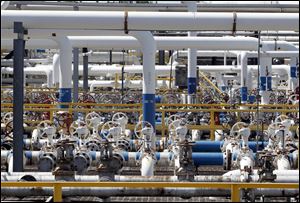
The pipeline manifold is part of the oil movement and storage area at the Husky Lima Refinery. This is the room the oil flows into, 160,000 barrels of crude a day from the Gulf of Mexico and Texas oil fields.
The Lima refinery receives nearly all of its crude oil by pipeline from the Gulf of Mexico and Texas, said training supervisor Roger Hornung. In addition to producing the equivalent of about 25 percent of the gasoline used each day in Ohio, the refinery produces diesel and jet fuels, residual fuels, and petrochemical feedstocks, some of which are delivered to chemical companies located adjacent to the Lima refinery.
Currently, the Lima Refinery has about 430 hourly employees working 12-hour shifts, and 120 contractors on site at any given time. Its hourly employees are represented by Local 624 of the United Steel Workers union.
Like the slightly larger PBF Toledo Refining Co. plant in East Toledo and neighboring Oregon, the Husky Lima Refinery is surrounded by industrial, commercial, and residential neighbors that reside in close proximity to its around-the-clock operations, some of which can be noisy and stinky at times.
But like the 116-year-old PBF refinery, the Lima refinery predates most of its neighbors and is viewed as a valuable contributor to the local community.
"They are paying substantial taxes, which holds down the amount that [residential] taxpayers in Shawnee are required to pay," explained Paul J. Nardini, the superintendent of the Shawnee Local School District in Lima. "Until there's a spill [or an incident], it's our refinery."
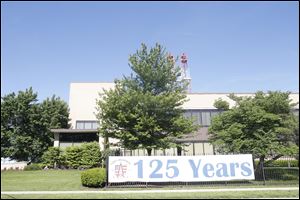
A sign of the times for the plant in Lima, Ohio, hangs on the facade of the refinery.
To a visitor, the refinery itself is a stone-lined maze of hissing steam vents, giant pipes, valves, and storage tanks, and signs warning of one danger after another.
The pipeline-delivered crude oil -- primarily West Texas sweet crude -- undergoes a series of refining steps as it traverses the various crackers, cokers, and other processing equipment on the grounds, separating into everything from gasoline and kerosene to benzene and fuel stock used in aluminum smelting.
Nearly every bit of the petroleum is used in the process, and even the plant's ubiquitous burn-off flare plays a high-tech role in keeping the whole process regulated.
"Nothing goes to waste here," said Michael Springer, a 36-year employee of the Lima refinery who is now the senior operations technical trainer.
But that wasn't always the case.
Lima and Findlay were both at the heart of the late 1800s oil boom in northwest Ohio as residents and speculators sunk wells into a giant crescent-shaped deposit of crude that stretched from Toledo southwest into central Indiana.

The sweetening stills begin to take shape in this photo, which was taken sometime during the oil boom.
Lima paper mill owner Ben Faurot was first to drill for oil after hearing of discoveries of natural gas in Findlay. His strike in 1885 attracted the attention of John D. Rockefeller, co-founder of Standard Oil Co. Mr. Rockefeller soon bought or leased much of the Lima oil field.
Between the time of Mr. Faurot's strike and 1900, the Lima oil field was the leading producer of oil in the world, producing 190 million barrels.
In 1886, Mr. Rockefeller's company began building what he named the Solar Refinery in Lima. Its main product in those early years was kerosene, which was replacing whale oil as a reliable fuel for lamps.
But a development that same year across the Atlantic would soon have a profound effect on the Solar Refinery and others in North America: Karl Benz patented the first gasoline-powered automobile in Germany, using what to that point had been a useless by-product of refining kerosene to power their internal combustion engines.
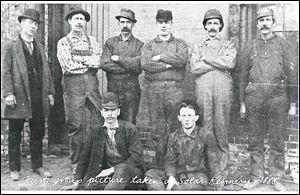
The first group of employees at Solar Refinery in Lima, Ohio, pose for a photograph in 1888.
The Lima refinery has gone by many names across its 125-year history, and has changed hands several times, although the pace of new nomenclature has picked up considerably during the last several decades.
The refinery went by the Solar name until 1931, when it became Sohio -- a name that would remain until 1986 when Standard Oil merged with British Petroleum.
BP PLC tried twice, unsuccessfully, to sell the Lima refinery in 1994 and 1996, when it said it was unprofitable, and announced in 1996 that it planned to close the facility.
But two years later, BP reached terms with Clark Refining and Marketing and sold the refinery in 1998. Clark changed its name to Premcor Inc. in 2000.
Lima Mayor David Berger, who's led the city for 22 years, said there was a great deal of dread in the city when BP said it planned to close the refinery and demolish it in 1996.
"We had lots of time to contemplate what the loss of the refinery was going to be, and it was absolutely enormous," Mayor Berger said. "A facility that provides hundreds of good-paying jobs in the city, is the city's largest water customer, a major corporate citizen, with dollars that flow to community projects and charities and talent that contributes to projects across our communities, would have been gone."
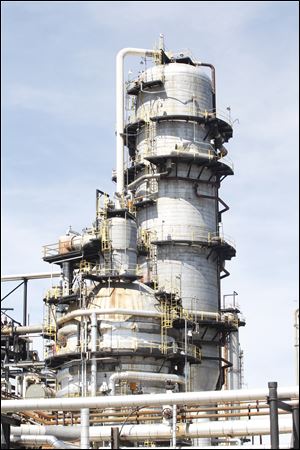
The vacuum and distillation tower at the Husky Lima Refinery is a prominent part of the skyline.
The closure, he said, would have also meant shutting the adjacent chemical plants which receive raw materials from the refinery and process them into more useful consumer and industrial goods, a cascade effect that would have crippled Lima's economy.
"The long-term prospects with the loss of the refinery was that we were going to look at the loss of hundreds more jobs and end up with about a 1,000-acre desert. The community's well-aware of the facility, and we're proud of the job it does and the economic impact that it has."
In 2005, the refinery changed hands again as Premcor was purchased by Valero Energy Corp., of Texas, which turned around and sold the Lima facility to its current Canadian owner, Husky, in 2007, for $1.9 billion.
Roy Warnock, vice president and general manager of the Lima refinery, said the refinery is key to Husky's strategic plans. The company will consider how to upgrade the plant to enhance its processing of heavy crude oil, and expects to make considerable investments in Lima.
The plan received $132 million in new work last year, plus $46 million on maintenance, the company said.
Major projects are planned at the facility in 2014 and 2015.
AREA REFINERIES AT A GLANCE:
Husky Lima Refinery
Location: Shawnee Township (adjoining city of Lima)
Built: 1886
Refining capacity: 160,000 barrels of crude per day
Employees: 430
BP Husky Toledo Refinery
Location: Oregon
Built: 1919
Refining capacity: 160,000 barrels per day
Employees: 500
PBF Toledo Refining Co. (formerly Sunoco)
Location: Toledo and Oregon
Built: 1895
Refining capacity: 170,000 barrels per day
Employees: 600
Contact Larry P. Vellequette at:
lvellequette@theblade.com
or 419-724-6091